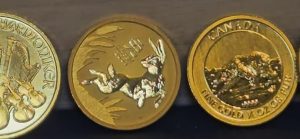
In an era marked by economic uncertainties and volatile financial markets, many individuals seek alternative investment opportunities to safeguard their wealth and diversify their portfolios. Precious metals like gold, silver, platinum, and palladium have historically been considered safe-haven assets, serving as a store of value and a hedge against inflation. Among the numerous companies offering precious metals investment services, Advantage Gold has garnered significant attention. But is Advantage Gold legitimate, and can it be trusted with your hard-earned money? In this two-part article, we aim to provide you with an in-depth analysis of Advantage Gold and its legitimacy as a precious metals investment company.
The Basics of Precious Metals Investment
Before delving into the specifics of Advantage Gold, it’s essential to understand the basics of precious metals investment. Precious metals, such as gold and silver, have been coveted throughout history for their rarity, beauty, and intrinsic value. They have been used as forms of currency, jewelry, and even as a means of preserving wealth. In modern times, they continue to hold their allure, particularly as a means of diversifying one’s investment portfolio.
Investing in precious metals can take various forms:
- Physical Bullion: This involves purchasing physical gold or silver bars, coins, or other forms of tangible metal. These assets are typically stored in a secure location, such as a bank vault or a private depository.
- ETFs (Exchange-Traded Funds): ETFs are investment funds traded on stock exchanges, representing a particular commodity or asset class, including precious metals. Investors can buy and sell shares in these funds, which are backed by physical metals held in storage.
- Mining Stocks: Investing in mining companies that extract and produce precious metals. The value of these stocks is influenced by factors such as production costs, mining exploration, and market demand.
- Precious Metals IRAs: These individual retirement accounts allow investors to hold physical precious metals within a tax-advantaged retirement account, providing a hedge against inflation and market volatility.
Advantage Gold primarily focuses on assisting investors with the last option – Precious Metals IRAs. Let’s take a closer look at the company and its offerings.
Related Article: An Investors Guide to Investing in Gold for Retirement
Advantage Gold: An Overview
Advantage Gold is a precious metals investment company based in Los Angeles, California. Founded in 2014, the company has gained recognition for its expertise in helping individuals diversify their retirement savings by adding precious metals to their portfolios through self-directed Individual Retirement Accounts (IRAs). Self-directed IRAs offer investors more control over their retirement funds and allow them to invest in alternative assets like precious metals, real estate, and private equity.
Here are some key aspects of Advantage Gold:
1. Focus on Precious Metals IRAs
Advantage Gold’s primary service revolves around helping clients establish and manage Precious Metals IRAs. These IRAs enable individuals to invest in IRS-approved precious metals, including gold, silver, platinum, and palladium, within a tax-advantaged retirement account.
The process typically involves the following steps:
- Opening a self-directed IRA account through a trusted custodian.
- Funding the IRA account with a rollover from an existing retirement account or through a new contribution.
- Selecting the desired precious metals for purchase.
- Facilitating the purchase and secure storage of the chosen metals.
- Ongoing account management and reporting.
By focusing on Precious Metals IRAs, Advantage Gold aims to provide clients with a tax-efficient way to protect and grow their wealth using physical precious metals.
2. Expertise and Guidance
Advantage Gold prides itself on its team of experts who are well-versed in the intricacies of precious metals investment and retirement planning. The company’s representatives work closely with clients to educate them about the benefits and risks of investing in precious metals and guide them through the process of setting up and managing their Precious Metals IRAs.
Clients are often assigned a dedicated account executive who can offer personalized assistance and answer any questions they may have regarding their investments.
3. Transparent Pricing
One of the key factors that investors consider when choosing a precious metals investment company is transparency in pricing. Advantage Gold is committed to providing clear and transparent pricing for its services. They emphasize a no-hidden-fees approach and strive to ensure that clients have a comprehensive understanding of the costs involved in setting up and maintaining their Precious Metals IRAs.
The transparency in pricing is intended to help clients make informed decisions and avoid unexpected charges that may erode their investment returns.
4. Secure Storage Solutions
Advantage Gold understands the importance of secure storage for precious metals. When clients purchase physical metals through the company, they offer options for storage in IRS-approved depositories. These depositories are equipped with state-of-the-art security measures and insurance coverage, providing clients with peace of mind regarding the safety of their investments.
Related Article: Can You Buy Gold Through Morgan Stanley?
Is Advantage Gold Legitimate?
Now that we have outlined the basics of Advantage Gold and its services, the pressing question remains: Is Advantage Gold legitimate? To answer this question, we need to examine several critical factors and consider the experiences of investors who have engaged with the company.
Regulatory Compliance
One of the first aspects to evaluate when assessing the legitimacy of a precious metals investment company is its compliance with regulatory requirements. The precious metals industry is subject to oversight by various regulatory bodies, including the Internal Revenue Service (IRS) and the Securities and Exchange Commission (SEC).
Advantage Gold emphasizes its commitment to compliance with all relevant regulations, particularly those related to Precious Metals IRAs. This includes adhering to IRS guidelines for allowable precious metals within IRAs, ensuring proper reporting, and facilitating the necessary paperwork.
To verify Advantage Gold’s compliance, prospective investors should conduct their due diligence by researching the company’s regulatory history and confirming its adherence to industry standards.
Customer Reviews and Testimonials
A valuable source of information when assessing the legitimacy of any company is customer reviews and testimonials. Real-life experiences from clients who have engaged with Advantage Gold can provide valuable insights into the company’s operations, service quality, and overall legitimacy.
Potential investors should seek out independent reviews on reputable platforms and forums. It’s essential to consider both positive and negative feedback and weigh the overall sentiment of clients who have worked with Advantage Gold.
Positive reviews may highlight aspects such as:
- Transparent pricing.
- Knowledgeable and responsive customer service.
- Secure and reliable storage options.
- Efficient account setup and management.
Negative reviews, on the other hand, may raise concerns about:
- Delays or issues with metal deliveries.
- Miscommunication or misunderstandings.
- Discrepancies in pricing or fees.
By thoroughly researching customer reviews, potential investors can gain a more comprehensive understanding of Advantage Gold’s legitimacy and its track record in serving clients.
Third-Party Ratings and Accreditations
Another method of assessing the legitimacy of a precious metals investment company is to consider any third-party ratings and accreditations it has received. Independent organizations may evaluate companies within the industry based on various criteria, such as customer satisfaction, business ethics, and industry expertise.
Advantage Gold has received accreditation from the Better Business Bureau (BBB) and maintains an A+ rating with the organization. The BBB assesses companies based on factors like complaint history, transparency, and customer service. A high rating from the BBB is often seen as a positive indicator of a company’s legitimacy and commitment to customer satisfaction.
Transparency and Education
Legitimate precious metals investment companies, like Advantage Gold, prioritize transparency and investor education. They recognize the importance of ensuring that clients understand the risks and benefits of investing in precious metals and provide educational resources to facilitate informed decision-making.
Advantage Gold offers educational materials, including articles, guides, and webinars, to help clients navigate the complexities of precious metals investment and retirement planning. This commitment to transparency and education is a positive sign for investors who value being well-informed about their financial choices.
Red Flags to Watch Out For
While conducting due diligence on Advantage Gold, or any precious metals investment company, it’s essential to be vigilant for potential red flags. Some warning signs that should raise concerns include:
- Unrealistic Promises: Be cautious of companies that make unrealistic promises of guaranteed returns or overly aggressive sales tactics.
- Lack of Transparency: If a company is unwilling to provide clear information about pricing, fees, and storage options, it may be cause for concern.
- Negative Reviews and Complaints: A pattern of unresolved customer complaints or a high volume of negative reviews should be taken seriously.
- No Regulatory Compliance: If a company is not forthcoming about its regulatory compliance or fails to provide necessary documentation, it may be operating unlawfully.
- Pushy Sales Tactics: High-pressure sales tactics and a sense of urgency to make an investment decision should be viewed with skepticism.
In Part 1 of this article, we examined the basics of Advantage Gold and explored factors such as its focus on Precious Metals IRAs, expertise, transparent pricing, and secure storage solutions. Now, in Part 2, we continue our investigation into Advantage Gold’s legitimacy by considering regulatory compliance, customer reviews, third-party ratings, transparency, and potential red flags.
Regulatory Compliance
Advantage Gold’s emphasis on regulatory compliance is a critical aspect when evaluating its legitimacy. The IRS has strict guidelines for the types of precious metals that can be held within IRAs. These guidelines include the requirement that the metals must meet specific purity standards and be held by an approved custodian or trustee.
To ensure that Advantage Gold adheres to these regulations, potential investors should request documentation that confirms the company’s compliance. Reputable precious metals investment firms should be forthcoming with this information and willing to provide clarity on their adherence to IRS guidelines.
Customer Reviews and Testimonials
Customer reviews and testimonials play a pivotal role in assessing Advantage Gold’s legitimacy. As mentioned earlier, it is essential to consider both positive and negative feedback to form a balanced perspective.
Positive reviews often highlight aspects of Advantage Gold’s services that have exceeded clients’ expectations, such as:
- Smooth and efficient account setup.
- Assistance in selecting suitable precious metals.
- Reliable and secure storage options.
- Responsive and knowledgeable customer service.
Negative reviews may raise concerns about experiences that have fallen short of clients’ expectations, including:
- Delays in metal deliveries or transactions.
- Miscommunications or misunderstandings.
- Discrepancies in pricing or fees.
While negative reviews should not be dismissed outright, it is valuable to investigate the nature and context of such feedback. For example, some issues may be isolated incidents, while others may be indicative of systemic problems within the company.
Third-Party Ratings and Accreditations
Advantage Gold’s accreditation by the Better Business Bureau (BBB) and its A+ rating serve as positive indicators of the company’s legitimacy and commitment to customer satisfaction. However, it is essential to consider other third-party ratings and industry recognition as well.
Additionally, investors can check if Advantage Gold is a member of respected industry associations, such as the Industry Council for Tangible Assets (ICTA) or the Professional Numismatists Guild (PNG). Membership in such organizations can reflect a commitment to ethical business practices and industry standards.
Transparency and Education
Transparency and investor education are cornerstones of a legitimate precious metals investment company. Advantage Gold’s provision of educational materials and resources is a positive sign for investors who value being well-informed about their financial decisions.
Prospective investors should explore the company’s website and review its educational content to assess the depth and quality of information provided. Companies that genuinely prioritize investor education will offer a range of resources, including articles, guides, webinars, and FAQs, to empower clients with knowledge.
Red Flags to Watch Out For
As mentioned in Part 1, it is crucial to remain vigilant for potential red flags when assessing the legitimacy of any precious metals investment company. Some additional red flags to watch out for include:
- Unverifiable Claims: Companies that make claims that cannot be independently verified, such as promises of high, guaranteed returns, should be approached with caution.
- Lack of Clarity on Fees: If a company is evasive about its fee structure or provides incomplete information, it may be hiding hidden costs that could impact your investment.
- Inadequate Security Measures: Companies that do not prioritize the security of your precious metals, including secure storage options, may pose a risk to your investment.
- No Physical Presence: While some legitimate companies operate primarily online, a complete absence of physical presence or verifiable contact information may be a red flag.
- Pushy Sales Tactics (Continued): Companies that pressure you to make hasty investment decisions without giving you time to conduct due diligence should be viewed skeptically.
Conclusion
In conclusion, the legitimacy of Advantage Gold as a precious metals investment company hinges on several key factors. These factors include regulatory compliance, customer reviews, third-party ratings, transparency, and potential red flags.
Advantage Gold’s emphasis on regulatory compliance, particularly with IRS guidelines for Precious Metals IRAs, is a positive indicator of its commitment to operating within the bounds of the law.
Customer reviews and testimonials, both positive and negative, provide valuable insights into the company’s track record and customer satisfaction. Investors should carefully consider the nature and context of such feedback.
Third-party ratings and accreditations, such as the A+ rating from the Better Business Bureau, reflect external assessments of the company’s operations and ethics.
Transparency and investor education are crucial aspects of a legitimate precious metals investment company. Advantage Gold’s commitment to providing educational resources can empower investors to make informed decisions.
Finally, potential investors should remain vigilant for red flags that may indicate questionable practices. These include unverifiable claims, lack of fee transparency, inadequate security measures, absence of physical presence, and pushy sales tactics.
Ultimately, whether Advantage Gold is the right choice for you depends on your individual financial goals, risk tolerance, and investment preferences. It is advisable to conduct thorough due diligence, seek advice from financial professionals if necessary, and make an informed decision that aligns with your financial objectives and values. Remember that all investments carry risks, and past performance is not indicative of future results.


